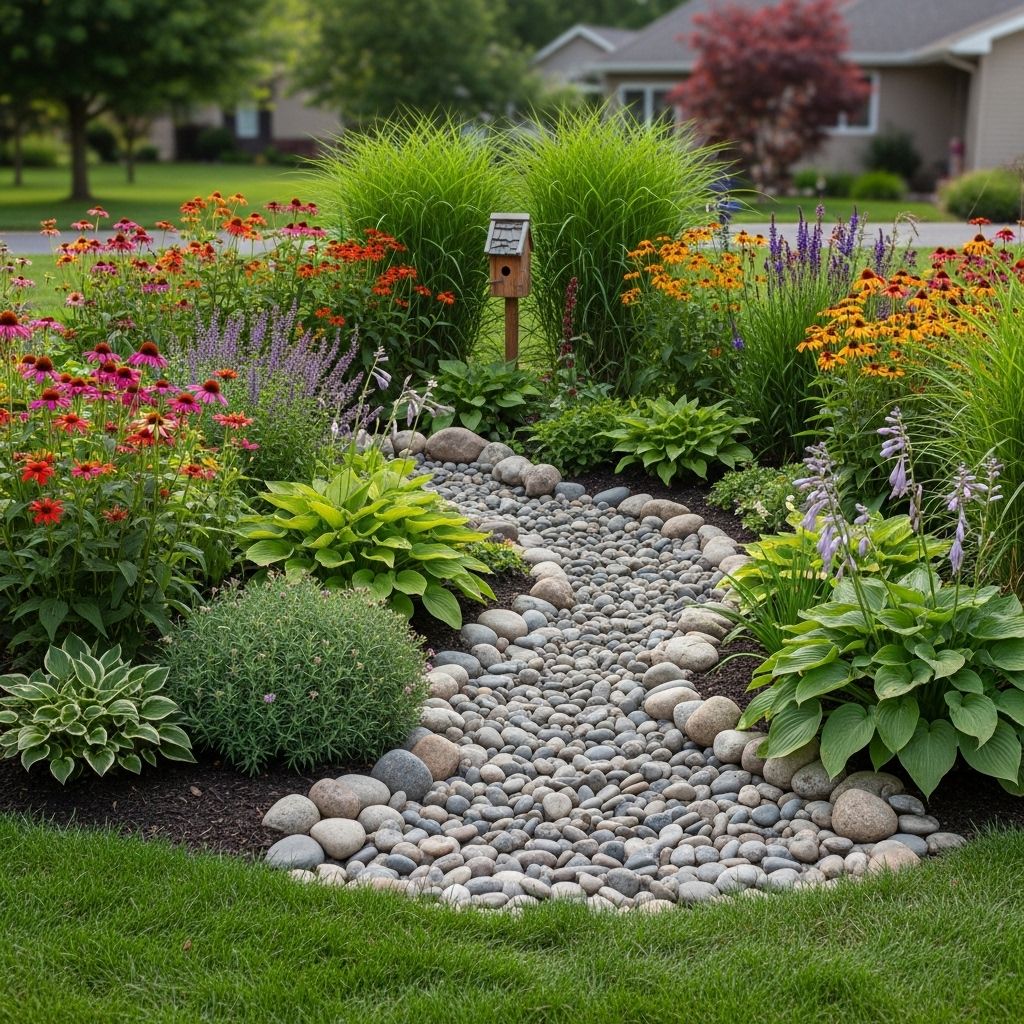Rain Garden Design: 7 Essential Steps For A Thriving Yard
Discover how rain gardens transform landscapes, manage stormwater, and foster vibrant ecosystems at home.

Image: HearthJunction Design Team
Rain Gardens: Eco-Friendly Solutions for Stormwater Management
Rain gardens are more than just beautiful landscape features—they are powerful tools for managing stormwater, preventing runoff pollution, and enhancing biodiversity. This comprehensive guide covers the essentials of rain garden design, their environmental impact, and how to create and maintain one in your own yard.
What Is a Rain Garden?
A rain garden is a shallow, vegetated depression strategically placed to capture and filter stormwater runoff from roofs, driveways, streets, and patios. Designed to mimic natural water absorption, rain gardens collect rainfall and allow it to gradually infiltrate into the ground, rather than flowing into storm drains or across impervious surfaces. In doing so, they reduce runoff, address drainage issues, and help clean urban watersheds.
Key Features of a Rain Garden
- Shallow Basin: Typically 4–8 inches deep to capture and hold runoff temporarily.
- Amended Soil: A blend of sand, compost, and existing soil to boost drainage and filtration.
- Native Plants: Deep-rooted natives that absorb water, improve soil, and attract wildlife.
- Strategic Placement: Installed away from building foundations and septic systems, ideally positioned to intercept runoff from impermeable areas.
How Do Rain Gardens Work?
Rain gardens operate by intercepting stormwater as it flows off hard surfaces. The planted basin holds this water briefly, allowing it to soak into the enhanced soil mix below. As water percolates, plant roots and soil microbes break down pollutants, sediments, and nutrients, delivering cleaner water to local groundwater and streams. This process mimics natural hydrological cycles while supporting plant and animal life.
Steps of Rain Garden Function
- Stormwater flows from a downspout, driveway, or street into the garden.
- Water pools in the shallow basin, spreading across the garden’s surface.
- Soil and roots absorb and filter the water, removing contaminants.
- Filtered water infiltrates the subsoil, recharging groundwater.
- Excess water slowly drains, preventing ponding and flooding.
Benefits of Rain Gardens
| Benefit | Description |
|---|---|
| Stormwater Management | Captures and soaks up rainfall runoff, reducing peak flows and erosion. |
| Flood Prevention | Diversion of runoff protects foundations and basements from flooding when placed at least 10 feet away from structures. |
| Water Quality Improvement | Filters pollutants (fertilizers, oil, debris) before they reach waterways. |
| Biodiversity Support | Provides vital habitat for pollinators, birds, and beneficial insects. |
| Aesthetic Appeal | Enhances landscape with color, texture, and year-round interest. |
| Groundwater Recharge | Facilitates percolation, helping maintain healthy aquifers. |
| Increased Property Value | Attractive rain gardens can increase home value and curb appeal. |
| Available Incentives | Many areas offer rebates or incentives for installing rain gardens. |
Improved Water Management
Rain gardens can absorb up to 30% more water than a typical lawn. This dramatically reduces the risk of water pooling or soggy areas in your yard and helps prevent troublesome runoff issues. They also help slow water movement, which means less erosion and sediment transport during storms.
Environmental Benefits
- Significantly reduce the volume of polluted runoff entering sewers and waterways.
- Decrease frequency and severity of local flooding by diverting water away from homes.
- Support local ecosystems by providing food and shelter for pollinators and birds.
- Improve water quality by filtering out fertilizers, oils, and debris.
- Recharge groundwater aquifers, especially important during dry periods.
Other Advantages
- Low Maintenance: Once established, native plants in rain gardens require less water and fertilizer.
- Customizable Design: Incorporate sculptural elements, stones, and personal touches for unique garden style.
- Cost Savings: Reduced need for irrigation, fertilizers, and stormwater management infrastructure.
Designing a Rain Garden
Site Selection
- Choose an area at least 10 feet away from house foundations, septic tanks, and wells.
- Locate at the bottom of a slope or where water naturally flows after rain.
- Avoid areas where water ponds for long periods or near large tree roots.
Determining Size and Shape
- The garden size depends on the catchment area (roof, driveway, etc.).
- Typical rain gardens range from 100 to 300 square feet, but larger or smaller designs are possible.
- Shape is flexible—curved, kidney-shaped, or rectangular designs often blend well with existing landscapes.
Soil Preparation and Amendments
- Excavate the basin 4–8 inches deep.
- Mix in compost and sand to boost drainage and fertility.
- Aim for a soil mix of approximately 50–60% sand, 20–30% topsoil, and 20–30% compost.
Plant Selection: The Power of Natives
Native plants are essential to a rain garden’s function and resilience. Deep-rooted species absorb water quickly and filter out impurities while thriving in local conditions. Mixing diverse heights, bloom times, and textures maximizes both beauty and ecological benefits.
Popular Native Plants for Rain Gardens
- Swamp Milkweed (Asclepias incarnata)
- Blue Flag Iris (Iris versicolor)
- Switchgrass (Panicum virgatum)
- Cardinal Flower (Lobelia cardinalis)
- Black-eyed Susan (Rudbeckia fulgida)
- Joe-Pye Weed (Eutrochium purpureum)
- Wild Bergamot (Monarda fistulosa)
- Purple Coneflower (Echinacea purpurea)
Plant densely to discourage weeds and mulch with shredded hardwood or leaf litter to retain moisture.
Layered Planting Zones
- Center: Moisture-loving species for the deepest part of the garden.
- Slopes: Plants that tolerate both wet and dry cycles.
- Edges: Drought-tolerant natives to transition to lawn or other landscape beds.
Building a Rain Garden: Step-by-Step
- Assess Your Site: Map the flow of water from roofs, driveways, and yards to determine the best garden location.
- Size the Garden: Calculate the runoff area and use a rain garden sizing calculator for guidance (e.g., 10–20% of the contributing impervious area).
- Excavate and Amend: Dig your depression and amend the soil as described above.
- Shape the Basin: Form a gentle slope toward the center with a flat bottom and berm around the lower edge to retain water.
- Plant: Position plants according to their water needs, placing moisture-loving plants in the deepest section.
- Mulch: Add 2–3 inches of shredded hardwood mulch to retain moisture and suppress weeds.
- Water and Establish: Water regularly the first season until plants are established; after that, supplemental watering is rarely needed.
Maintenance Tips for Thriving Rain Gardens
- Weed regularly, especially in the first two years as plants establish.
- Replenish mulch annually to maintain a 2–3 inch layer.
- Remove debris and sediment from inflow areas to keep water moving freely.
- Prune or replace plants as needed to maintain density and diversity.
- Inspect after major storms for erosion or pooling and repair as necessary.
Creative Enhancements and Personalization
Rain gardens offer numerous opportunities for creative expression. Incorporate:
- Stone pathways, decorative boulders, or driftwood for structure.
- Benches or seating for wildlife observation.
- Garden art, sculptures, or even water features for unique flair.
Each garden reflects the personality of its creator and the character of the local ecosystem.
Potential Incentives and Support
Many cities and local governments now offer rebates or technical assistance for rain garden installation, especially in regions with chronic runoff or water quality concerns. Check with municipal agencies or conservation organizations for details on available programs and eligibility.
Frequently Asked Questions (FAQs)
Q: Will a rain garden attract mosquitoes?
A: No, rain gardens are designed to drain within 24–48 hours after rainfall, preventing standing water long enough for mosquito breeding.
Q: Does a rain garden require special maintenance?
A: After the first couple of years, maintenance is minimal—mostly limited to seasonal weeding, occasional mulching, and plant care.
Q: Can a rain garden handle heavy rain or drought?
A: Yes, the soil mix and plant choices allow rain gardens to tolerate both heavy downpours and dry spells, provided they are designed and planted correctly.
Q: Are rain gardens expensive to install?
A: Costs vary, but DIY rain gardens can be affordable, especially when using local plants and materials. Long-term savings on irrigation, fertilizer, and drainage improvements often offset initial costs.
Q: Why use native plants?
A: Native plants are adapted to local weather and soil, require less water, are more disease-resistant, and better support local wildlife and pollinators.
Conclusion
Rain gardens are a smart, sustainable addition to any landscape, offering beauty, ecological benefits, and practical stormwater management. By harnessing rainfall as a resource—not a nuisance—you can protect waterways, enrich your property, and create a thriving habitat for local wildlife. Whether your garden is large or small, every step toward capturing and filtering stormwater makes a difference for the environment and your community.
References
- https://lawnlove.com/blog/rain-garden-benefits/
- https://www.pleasanthilliowa.org/681/Rain-Garden-Benefits
- https://www.mmsd.com/what-we-do/green-infrastructure/rain-gardens
- https://www.ncei.noaa.gov/data/oceans/coris/library/NOAA/CRCP/other/other_crcp_publications/Watershed_USVI/stx_ee_hope_carton_road/130123_AttachmentC_11103.pdf
- https://warelandscaping.com/resources/rain-garden/
Read full bio of Srija Burman












